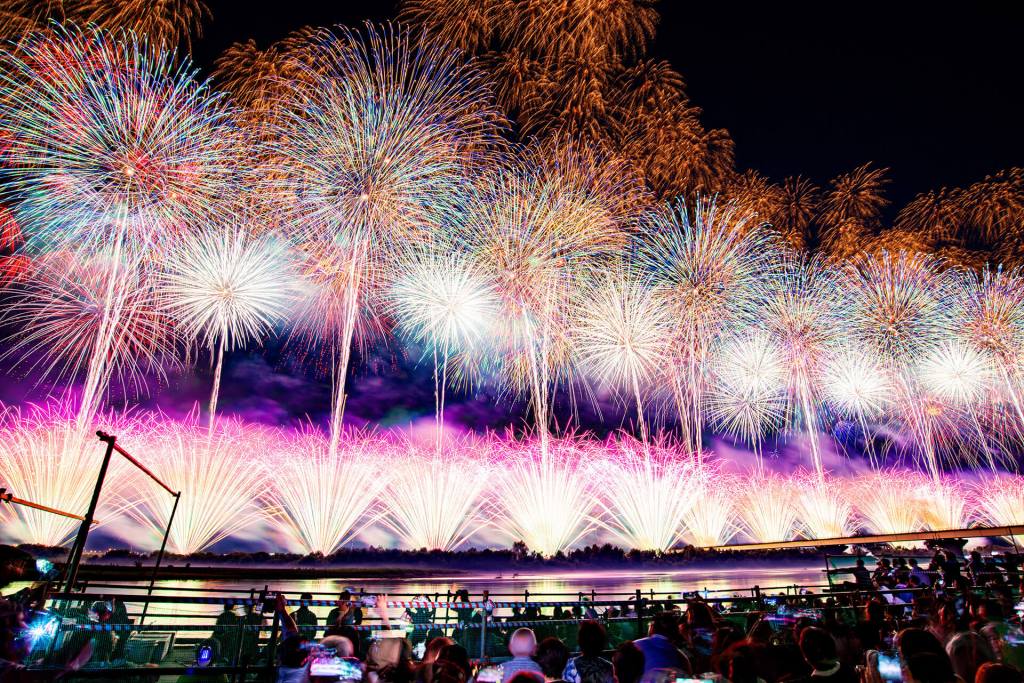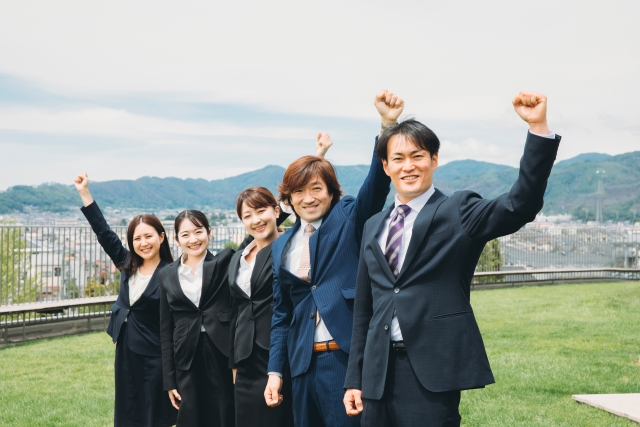Summer is a special season for active play, with many events and activities to enjoy. We will introduce events that allow you to fully enjoy this special time of summer, as well as activities that will help you feel the sadness of the end of summer.
Summer Festival, a typical summer tradition
The first thing that comes to mind when thinking about summer is the summer festival. It is said that the number of summer festivals held in Japan is approximately 300,000, and festivals of various sizes are held all over the country during the summer. Wear yukata and go to festivals, eat takoyaki and okonomiyaki at food stalls, watch fireworks, and dance the Bon dance. There are many different types of summer festivals, and even within the same type, the content differs depending on the region, so each festival has its own unique appeal. To help you understand the appeal of summer festivals, let’s introduce in more detail the types of summer festivals and how to enjoy them.
Fireworks display, a staple of summer festivals

There are various types of summer festivals, but the most representative one is the fireworks festival. Countless fireworks festivals are held in Japan from summer to autumn. Among these, the most popular fireworks festival is called Japan's three major fireworks festivals'' and attracts many spectators from Japan and abroad. If you want to know about Japan's famous fireworks festivals and their charm, please refer to this article. Fireworks display, a typical summer festival event “Bon Odori” is a festival where you can enjoy together with local people Bon Odori” is a festival in which participants sing and dance to the sound of drums and flutes. Bon'' is the period during which the spirits of the deceased return to this world from the afterlife. Based on the belief that people become spirits after death and watch over their families and descendants, and the custom of praying for the repose of the souls of their ancestors, there is a culture that welcomes spirits returning to this world during the Obon period. Bon Odori not only has the meaning of entertaining spirits returning to this world, but also encourages interaction with local people, and was even used as a meeting place for men and women in the Edo period. This event is perfect for tourists who want to interact with local people.

There are manyBon Odori” that you can jump in to, so why not try it out?Mikoshi carrying'' is overwhelmed by the energetic shouts Another event unique to summer festivals is the mikoshi carrying event, in which people wearing loincloths and happi hats carry a mikoshi, shouting energetically, and parade it through the town.Mikoshi” refers to the vehicle of the god,'' and it is said that the god comes out of the shrine during festivals, spreads great power, and purifies disasters and impurities. The sight of all the participants working together to carry the mikoshi, which weighs at least several hundred kilograms, is very impressive. Unfortunately, you won't be able to participate in the event, but you can enjoy carrying the mikoshi as if it were a parade. Mikoshi carrying” paraded through the town is also an event unique to summer festivals.


Yukata wears a summer atmosphere
When it comes to summer festivals, you can’t miss wearing a yukata. Yukata, a type of kimono, is different from other kimonos in that it is made of thin fabric that easily absorbs sweat. During the Edo period, when fireworks displays originated, it was popular to wear yukata to festivals and cherry blossom viewing, so people have traditionally enjoyed wearing yukata when it comes to fireworks displays. There are some shops where you can rent yukata, so be sure to enjoy the summer festival in a yukata to fully enjoy Japan’s summer festivals.

Rent a yukata and go to a summer festivalYatai'' where you can have fun while feeling the summer atmosphere There are many small shops calledyatai” set up at the summer festival venue. In addition to restaurants serving dishes such as Takoyaki'',Yakisoba”, Shaved Ice'', andCandy Apples”, there are also shops where you can play games such as Goldfish Scooping'' andShooting Target”. In addition to the main events of fireworks and Bon Odori, you can also enjoy the summer festival atmosphere by wearing yukata, eating street food, and playing games at the stalls.
”Stalls” are essential for feeling the summer atmosphere

A rare sight that lights up the summer night sky: “Okuribi” and “Okuribi”
Like Bon Odori, Okuribi and Okuribi are held during the Bon festival. The fire that is lit as a mark to welcome the spirits of the ancestors who return during the Obon festival is called the Okuribi, and the fire that is lit at the end of the Obon festival to send off the spirits of the ancestors is called the Okuribi. At the Gozan Okuribi'' held in Kyoto, you can see a rare sight where a fire is lit in the mountains and characters such asDai” and “Myo” light up the summer night sky, so if you visit Kyoto in the summer, be sure to participate. I want you to.
Scenes seen at the Gozan Okuribi festival held in Kyoto

“Sea bathing” is a classic summer leisure activity.
Since Japan is an island country surrounded by the sea, many Japanese people go to the sea in the summer. There are plenty of spots where you can enjoy activities such as surfing and snorkeling, but the unique way to enjoy it that only Japanese people can enjoy is watermelon splitting''.Watermelon splitting” is a game in which a blindfolded person places a watermelon on a leisure sheet and uses a stick to break it using only the voices of those around him. In between swimming in the sea, let’s have a watermelon split and eat the broken watermelon together. Many Japanese people play with hand-held fireworks after sunset. When you go swimming at the beach, please try to imitate the Japanese way of enjoying themselves.
Enjoy “Watermelon Splitting” in between swimming at the beach
“Beer Garden” with a uniquely Japanese style
In the summer, Beer Gardens'' are held on the rooftops of various shops and facilities, where you can enjoy food and drink beer in a uniquely Japanese style. Many Japanese people enjoy drinking beer with co-workers and friends in an open space when the temperature drops a little from evening to night. After enjoying all the sightseeing, let's soothe the day's fatigue at abeer garden” with a uniquely Japanese style.

“Beer Garden” where you can enjoy beer in an open space on the rooftop

“Sparklers” where you can feel the unique Japanese emotionSparkler fireworks'', a type of handheld fireworks, take several tens of seconds from lighting to extinguishing. They are ephemeral fireworks that will go out of flame if they shake even a little. Fireworks change through four stages over time, and some say that these changes represent a person's life. Many Japanese people feel emotional about the ephemeral beauty and change of seasons, combining them with the sadness of the end of a special season and the transition from summer to autumn. How about immersing yourself in the memories of sightseeing while lighting sparklers on the last day or the day before your sightseeing trip? Sparkler fireworks” often enjoyed at the end of summer
4 gourmet foods that Japanese people eat in summer to get a summer feel
Japan’s hot and humid summer is exhausting. Therefore, there is a habit of eating nutritious foods to recover from fatigue. There are some summer gourmet foods that are easy to eat even if you don’t have an appetite, so if you’re tired of sightseeing in the summer, be sure to try the gourmet foods we’ll introduce below. In addition to that, we will also introduce gourmet foods that Japanese people enjoy during summer.

Watermelon, a classic summer gourmet dish
“Watermelon” is a well-established summer tradition in Japan. It has a long history and is said to have been popular as a food for the common people during the Edo period. It is rich in not only water but also minerals and vitamins, making it perfect for rehydrating, making it a popular summer vegetable. If you are tired of the hot summer in Japan, please try this.
“Watermelon” has become a summer tradition

“Somen” is a common dish eaten in summer in Japanese households.
Because of its refreshing taste, somen'' is easy to eat even on days when you don't have an appetite due to the heat. One of its appeals is that it can be eaten in a variety of ways, not just by simply cooling the boiled noodles and dipping them in cold noodle soup.Nagashi somen” is also a summer dish where you can make a channel by cutting bamboo pieces in half lengthwise and connecting them to let water and somen noodles flow through it, then eat the somen noodles as they flow. If you are tired and have no appetite during the hot summer in Japan, please try somen.
Nagashi Somen, a summer tradition

“Eel” helps your body recover from the summer heat
In Japan, there has long been a custom of eating eel,'' which is rich in nutrients, in order to relieve thesummer fatigue” that leaves the body tired and unable to cope with the hot summer weather. In particular, Doyou no Ushi no Hi'' is considered a day to eat eel, and many Japanese eat eel to survive the hot summer. To build up your stamina for sightseeing, why not try eating eel on your first day sightseeing in Japan? Eel” is perfect for building up your stamina for sightseeing

Ramune is the best carbonated drink of summer.
Ramune is a bottle of lemon-flavored soda. The mouth of the bottle is closed with a marble, and you push the marble into the bottle to open the mouth. Although it’s a little inconvenient, you’ll definitely find it fun to push the marbles in and open the spout. Many Japanese people think of ramune when they think of summer carbonated drinks, as it is sometimes sold at food stalls.
Ramune is a fun drink to open.

Cool down with all five senses! A Japanese way to cool down
In order to survive the hot and humid summer, Japanese people have come up with various ideas. Let’s introduce how to feel the “coolness” with all five senses, packed with the wisdom of the Japanese people.

Kawadoko/Nouryoudoko'' where you can cool down in various senses Kawadoko are outdoor seating areas set up at riverside restaurants to help people stay cool during the hot and humid summer. This is a culture that originated in Kyoto, and is famous for theKamogawa Noryodoko,” an outdoor seating area set up along the Kamo River only during the summer, and the Kibune Kawadoko,'' which is so close to the water that you can put your feet on it. While enjoying Kyoto cuisine at Kawadoko, you can cool off by looking at the smooth flowing river and feeling the pleasant breeze blowing through. Kibune Kawadoko” where the water surface is so close that you can put your feet on itWind chimes'' that make you feel cool from the sound Wind chimes are hung on the balcony of a house. A small piece called atongue” is suspended from a string on a bowl-shaped object made of glass or metal, and a strip of paper is attached to the bottom of the tongue to allow the wind to blow through it. Japanese people feel cool when the tongue'' of the strip of paper sways in the wind and hits glass or metal, creating a gentle yet cool tone. When Japanese people hear the sound of a wind chime, they think the wind is blowing, and some experiments have shown that it actually lowers body temperature. Beautiful wind chimes made using traditional techniques are perfect as souvenirs. "Wind chime" plays a cool tone “Uchimizu” is gaining attention again as an eco-friendly measure against the heat. Uchimizu is a method of sprinkling water around roads and houses, and using the effect ofheat of vaporization,” which takes away heat from the surrounding area when the water evaporates, it actually lowers the temperature of the surrounding area. It has been practiced in Japan since the Warring States period, and was not only used as a way to cool down, but also as a form of etiquette at the time. In modern Japan, it is attracting attention as an eco-friendly measure against the heat.

Uchimizu actually has the effect of lowering temperature
Shaved ice has a cold texture that keeps you cool.
The cool taste of shaved ice, which is made from finely shaved ice and topped with syrup, is loved by Japanese people and can often be found at food stalls at summer festivals. Japanese shaved ice has a distinctive crunchy texture, rather than the fluffy texture of Taiwanese shaved ice. There are many variations of shaved ice, including not only syrup but also condensed milk and red beans. Recently, due to the growing popularity of shaved ice, the number of shops specializing in shaved ice is increasing.

Shaved ice that makes your mouth feel cool
“Ghost stories” that lower your body temperature with chilling stories
Ghost stories, which tell terrifying stories, have become a form of summer entertainment in Japan. It is also unique to Japan that people listen to chilling stories to cool down during the hot summer months. In the Edo period, an event called “Hyakumonogatari” was already popular, where ghost stories were told around 100 candles and the candles were extinguished after each story. Even now, in the summer in Japan, there are many talk events where you can listen to ghost stories and horror-themed events. It may be difficult to attend a ghost story event, but why not try attending a horror-themed event to lower your body temperature?

Candles used in “Hyakumonogatari”
4 classic summer goods that are perfect as souvenirs
Introducing items that have become a summer tradition and items with Japanese patterns that give you a cool feeling. Why not take home a souvenir of summer in Japan?

“Mosquito coil” that brings the scent of summer home with you
Summers in Japan have traditionally been full of mosquitoes, and there is a custom of burning incense sticks containing insecticidal ingredients to exterminate mosquitoes, and their scent has become a summer tradition.




コメントを残す